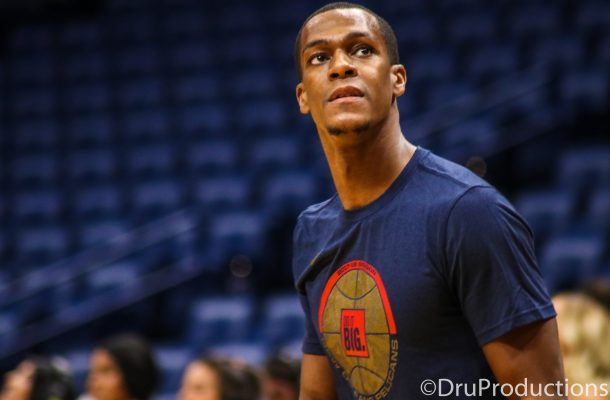« Anthony Davis Considered “day-to-day” due to Adductor Strain
Can the Pelicans’ Hot 3-Point Shooting Continue? »
Rajon Rondo and the Pelicans’ Struggling Defense

Whether you want to use the “eye test” or the actual numbers, it is clear that the Pelicans have benefitted from Rajon Rondo’s presence on the offensive end of the court. The team’s offensive rating with Rondo on the floor is 6 points per 100 possessions better than when he is on the bench (106.1 vs. 112.1, which is the difference between a slightly above average offense and one that is better than every team except for the Rockets and Warriors this season).
Yet, the Pelicans’ defensive rating with Rondo on the floor is 116.1, a putrid mark which would easily result in the worst defense in the league over the course of the season. Over the past couple of seasons, Rondo’s teams were slightly worse defensively with him on the court vs. off, but nothing nearly as drastic as what we have seen so far this season. Which begs the question: why have New Orleans lineups that include Rondo allowed so many points? After digging into the data, three key factors arise.
Note: All stats below courtesy of NBA.com/stats.
- The Pelicans’ schedule ramped up significantly when Rondo got back. In games this season where Rondo has been out (including his first game back when he played under 5 minutes), their collective opponents’ average offensive rating is 103.5 through games on 12/11 (below average and approaching bottom-10). Opponents against whom Rondo has played, however, currently have an average offensive rating of 107.5 – easily a top-10 offensive number and close to top-5.
- Opponents are red hot from 3-point range. With Jameer Nelson on the floor, opponents are shooting 34.8% from distance, compared to 38.6% when he sits. Conversely, teams are shooting an incendiary 40.2% from long range against Rondo & only 35.7% when he sits. Is Nelson really that much better at guarding shooters than Rondo? Doubtful. But the Pels have run up against a lot of good shooters in opposing starting lineups since Rondo’s return, and it shows.
- Opponents are piling up the fast break points. The Pelicans turn the ball over less with Rondo on the floor (13.9% vs. 16.5% TOV rate), which leads to fewer easy buckets (15.8 vs. 18.7 points off of turnovers per 100 possessions). That’s the good news. The bad news is that the Pels have given up an astonishing 3 more fast break points per 100 possessions with Rondo on the court (18.8) vs. on the bench (11.5). Some additional thoughts on this particular stat:
- The offense generates 3.6 fewer free throw attempts per 100 possessions with Rondo, but any fast break advantage gained in that respect should mostly net out since the Pelicans also score better in general with Rondo.
- Rondo could direct more movement on offense that results in players ending up closer to the rim. Offensive rebounding numbers cast some doubt upon that theory (team OREB% is slightly lower with Rondo in vs. out), but there still could be some truth to it.
As a team, the Pelicans have been the worst in the NBA in stopping fast break points since Rondo got back, about 5 points per game worse than league average. While it would be foolish to place all of the blame on Rondo for this stat, it is nonetheless one that should be closely monitored moving forward.
Thoughts on why the numbers may look worse than what your eyes may be telling you? Or, conversely, do have you seen any activity specific to Rondo that has disproportionately hurt the Pelicans’ defense? Let us know on our Facebook page or on Twitter @BourbonStShots!




